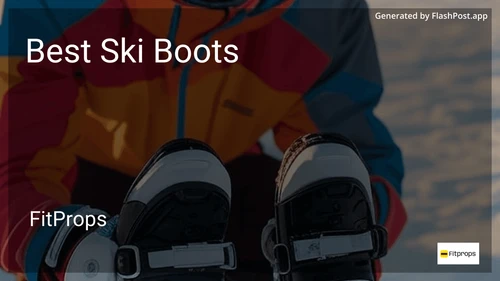Best Ski Boots to Buy in December 2025

Nordica The Cruise Men's Comfort Fit All Mountain Alpine Ski Boots (Black/White/Red, 27.5)
- EXCEPTIONAL COMFORT WITH EXTRA WIDE FIT FOR ALL-DAY PERFORMANCE.
- EASY ENTRY AND EXIT WITH DUAL SOFT FLAP INSTEP DESIGN.
- CUSTOMIZABLE FIT WITH NORDICA'S INFRARED TECHNOLOGY.



Nordica The Cruise Men's Comfort Fit All Mountain Alpine Ski Boots (Black/White/Red, 29.5)
- ANATOMICAL 104-MM LAST FOR MAXIMUM CONTROL AND COMFORT.
- EXTRA WIDE FIT WITH EASY ACCESS DUAL SOFT FLAP INSTEP.
- CUSTOMIZABLE FIT USING INNOVATIVE INFRARED TECHNOLOGY.



findway Ski Goggles OTG - Over Glasses Snow/Snowboard Goggles for Men, Women & Youth - 100% UV Protection
-
ULTIMATE ANTI-FOG DESIGN: STAY CLEAR WITH ADVANCED VENTILATION FOR FOG-FREE VISION.
-
DURABLE & SAFE: IMPACT-RESISTANT, UV PROTECTION, AND SCRATCH-PROOF LENS TECHNOLOGY.
-
OTG COMFORT FIT: WEAR OVER GLASSES, PERFECT FOR ALL WINTER SPORTS ACTIVITIES!



Nordica The Cruise Men's Comfort Fit All Mountain Alpine Ski Boots (Black/White/Red, 26.5)
- MAXIMUM CONTROL WITH A HIGH VOLUME COMFORT FIT FOR ALL-DAY SKIING.
- EASY ON/OFF WITH WIDE-OPENING DUAL SOFT FLAP INSTEP DESIGN.
- CUSTOMIZABLE FIT USING ADVANCED INFRARED TECHNOLOGY FOR PERFECT COMFORT.



Roces Idea Up Adjustable Ski Boots Black-Silver Size 22.5-25.5
-
GROWS WITH YOUR CHILD - ADJUSTABLE FROM SIZE 22.5 TO 25.5 FOR YEARS OF USE.
-
SECURE FIT FOR PERFORMANCE - 3 BUCKLES AND POWER STRAP FOR MAXIMUM COMFORT.
-
NO BINDING RE-MOUNT NEEDED - CONSISTENT SOLE LENGTH ENSURES HASSLE-FREE ADJUSTMENTS.



MAMBAOUT 2-Pack Snow Ski Goggles, Snowboard Goggles for Men, Women, Youth, Kids, Boys or Girls
- FAMILY-FRIENDLY: GOGGLES FIT EVERYONE 5+ FOR WINTER SPORTS FUN TOGETHER!
- VERSATILE USE: IDEAL FOR SKIING, BIKING, GAMING, OR ANY WINTER ACTIVITY!
- CLEAR VISION & COMFORT: FUNCTIONAL LENSES AND PLUSH PADDING FOR LONG WEAR!



NORDICA Women's The Cruise S W Ski Boots - Adult Winter Sports Downhill Alpine Ski Boots for Beginner and Intermediate Skiers, Black/Light Blue/White, 24.5
- EXPERIENCE ALL-DAY COMFORT WITH A FORGIVING 104MM WIDE FIT!
- ENJOY EFFORTLESS SKIING WITH A SOFT SHELL FOR BETTER CONTROL.
- QUICK AND EASY ENTRY WITH THE DUAL SOFT FLAP INSTEP DESIGN!



Rossignol Kelia 50 - Ski Boots for Women - Relaxed Fit Snow Ski Boots - Dark Iron
- COMFORT-FIRST DESIGN WITH A WOMEN'S-SPECIFIC RELAXED FIT.
- LIGHTWEIGHT SHELL FOR OPTIMAL ENERGY TRANSFER WHILE SKIING.
- EASY ENTRY SYSTEM FOR HASSLE-FREE BOOT ON/OFF EXPERIENCE.


Choosing the best ski boots can significantly enhance your skiing experience, ensuring comfort, performance, and safety on the slopes. With a myriad of options available, making the right choice may seem daunting. This guide will walk you through the essential factors to consider when selecting ski boots, helping you make an informed decision tailored to your needs.
Understanding Ski Boot Anatomy
Ski boots play a pivotal role in your overall skiing performance. Understanding the basic components can help you make a better choice:
- Shell: The hard outer part that provides structural support.
- Liners: The inner cushioning that provides comfort and warmth.
- Buckles: The closures that secure the boot on your foot.
- Soles: The bottom part of the boot that interfaces with the ski bindings.
Factors to Consider When Choosing Ski Boots
Selecting the perfect ski boots involves more than just finding the right size. Here are key factors to consider:
1. Fit and Comfort
A well-fitting ski boot is critical. Ensure that the boot offers a snug fit without being too tight. Remember, ski boots need to be comfortable for long skiing sessions, so consider trying them on with the socks you plan to ski in.
2. Flex Index
The flex index indicates the stiffness of the boot and should align with your skiing style and ability:
- Soft Flex: Suitable for beginners or lighter skiers, offering more comfort.
- Medium Flex: Versatile and suitable for intermediate skiers.
- Stiff Flex: Best for advanced skiers who require more control and precision.
3. Boot Last (Width)
Boot last refers to the width of the forefoot section. Choose a boot last that matches your foot's width:
- Narrow (97-98mm): Ideal for those with narrow feet.
- Medium (99-100mm): Fits a variety of foot shapes.
- Wide (101-104mm): Suitable for wider feet or those seeking extra comfort.
4. Skill Level and Type of Skiing
Your skill level and skiing style should greatly influence your choice:
- Leisure Skiing: Opt for comfort-oriented boots with a softer flex.
- Freestyle: Consider boots with a moderate flex for versatility.
- Racing: Choose high-performance boots with a stiff flex.
Tips for Trying Ski Boots
- Visit a reputable ski shop with knowledgeable staff.
- Wear your ski socks during fitting.
- Spend time walking around to ensure comfort.
- Don't rush the process; take time to find the perfect fit.
The Importance of Professional Fitting
While understanding these factors will guide you, investing in professional fitting is invaluable. Ski shops offer customization services to ensure your boots are tailored to your feet, enhancing comfort and performance on the slopes.
Additional Resources
If you're curious about enhancing your overall fitness and skiing performance, you may be interested in exploring high-quality skipping ropes for improved cardiovascular health or top LED skincare masks for rejuvenating your skin after a day in the cold.
Conclusion
Choosing the best ski boots is a personalized process that hinges on comfort, performance needs, and skiing style. Equip yourself with this knowledge and consider professional fitting services to ensure your experience on the slopes is as enjoyable and efficient as possible. Happy skiing!
